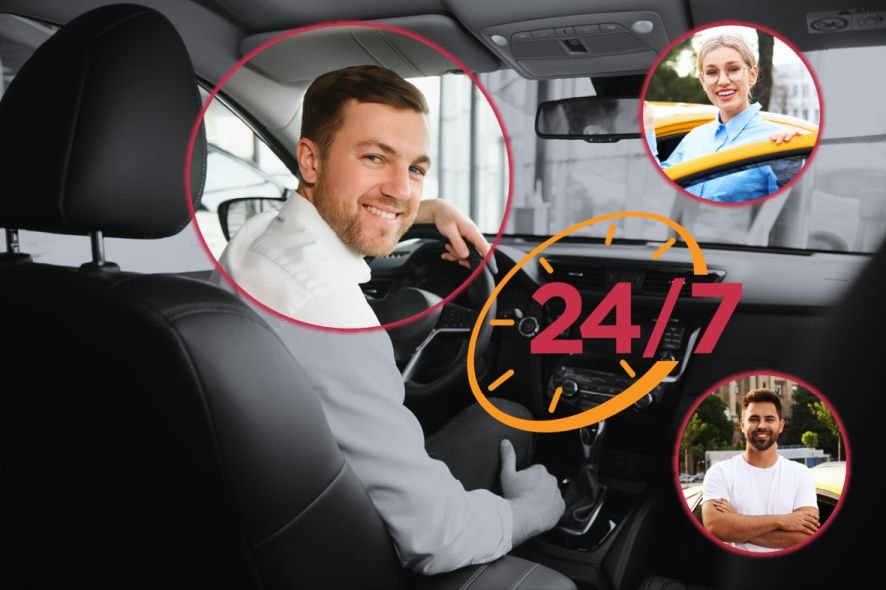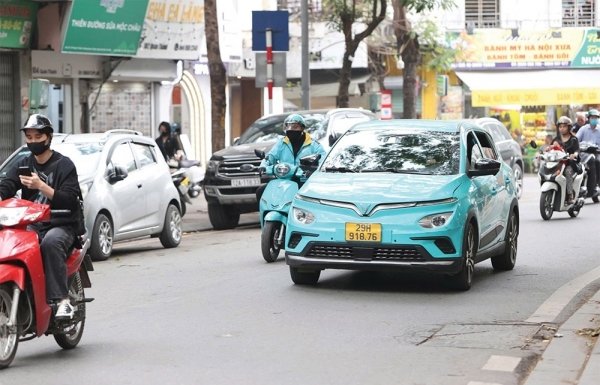Ride & Mobility
Navigating Didi Chuxing’s Challenges and MaaS Opportunities

China’s ride-hailing sector is undergoing a transformative phase as regulatory scrutiny intensifies and market dynamics evolve. At the center of this shift is Didi Chuxing, the dominant player in the industry, which faces a complex interplay of compliance pressures, financial recovery, and competition from emerging mobility-as-a-service (MaaS) alternatives. For investors, the sector presents a duality: the risks of regulatory overreach and market saturation, alongside the potential for innovation-driven growth in next-generation mobility platforms.
Regulatory Pressures and Didi’s Strategic Resilience
Since 2022, Didi has been under relentless regulatory scrutiny from China’s Ministry of Transport (MoT) and the Cyberspace Administration of China (CAC). The company was fined $1.2 billion for cybersecurity violations, forced to delist from the NYSE, and mandated to overhaul its data governance and driver qualification processes. These actions, while costly, have catalyzed operational restructuring. By 2025, Didi’s Q1 revenue grew 8.5% year-on-year to $7.42 billion, with net income rebounding to $240 million—up from a $130 million loss in Q1 2024.
However, the regulatory tailwinds are not entirely favorable. The MoT’s 2025 directive capping driver commissions at 20%-35% and mandating transparent pricing mechanisms has compressed Didi’s margins. While the company claims drivers now receive 79.1% of passenger revenue (vs. 20.9% for subsidies and profits), enforcement of driver qualification standards remains inconsistent. For instance, Shanghai’s 2022 inspection revealed 82% of Didi drivers were unqualified, prompting fines and reputational damage.
The company’s market capitalization has plummeted from a $68 billion IPO valuation in 2021 to $21 billion as of mid-2024, reflecting ongoing investor skepticism. Yet Didi’s pivot to Latin America and its expansion into financial services (e.g., debit cards, loans in Mexico) demonstrate strategic agility. Its partnerships with NVIDIA and WeRide in autonomous driving also position it to benefit from China’s $17.52 billion MaaS market opportunity by 2030.
Market Consolidation and the Rise of MaaS Alternatives
The regulatory crackdown has accelerated market consolidation, with smaller players struggling to meet compliance costs. This has created fertile ground for emerging MaaS startups, which are leveraging AI, electric vehicles (EVs), and integrated platforms to redefine urban mobility.
One standout is SAIC Mobility, the ride-hailing arm of state-owned automaker SAIC Motor. In Q2 2025, it secured $181 million in funding, signaling investor confidence in its hybrid model of traditional automotive manufacturing and digital mobility services. Similarly, Biren Technology, an AI chipmaker enabling autonomous driving, raised $207 million in 2025, underscoring the sector’s reliance on cutting-edge tech.
The MaaS ecosystem is also diversifying beyond ride-hailing. Startups are exploring low-altitude drone deliveries, EV charging networks, and AI-driven logistics. For example, Didi’s collaboration with NVIDIA to optimize routes using AI could reduce driver costs by 15%, enhancing its competitiveness. Meanwhile, government subsidies for green energy and smart city infrastructure are accelerating the adoption of electric and autonomous solutions.
Investment Implications and Strategic Considerations
For long-term investors, the sector’s bifurcation demands a balanced approach. Didi’s entrenched market position and technological R&D capabilities suggest it remains a key player, but its regulatory risks and margin pressures warrant caution. The stock’s recovery hinges on its ability to sustain compliance and capitalize on international markets, where it has shown resilience (e.g., 3.5 million active users in Peru by 2023).
Emerging MaaS startups, while riskier, offer higher growth potential. SAIC Mobility’s integration of automotive and digital services aligns with China’s 14th Five-Year Plan, which prioritizes smart cities and green tech. Biren Technology’s AI chips, critical for autonomous systems, could benefit from global demand for self-driving infrastructure. However, these firms face liquidity challenges, as China’s broader venture capital market contracted by 40% in 2023.
Recommendations for Investors:
1. Hedge Exposure: Allocate a portion of portfolios to Didi for its market dominance and R&D momentum, while diversifying into MaaS startups like SAIC Mobility or Biren Technology for high-growth opportunities.
2. Monitor Regulatory Signals: Closely track the MoT’s enforcement of driver qualification standards and pricing transparency rules, which could impact Didi’s margins and market share.
3. Leverage AI and EV Trends: Invest in platforms integrating AI-driven logistics and EV infrastructure, as these are central to China’s mobility strategy.
4. Assess International Expansion: Didi’s Latin American operations and financial services (e.g., 5 million loans issued in Mexico) highlight its potential to diversify revenue streams beyond China.
Conclusion
China’s ride-hailing sector is at a crossroads, with regulatory shifts reshaping the competitive landscape. While Didi Chuxing faces headwinds, its strategic pivots and technological investments position it to weather the storm. Meanwhile, the rise of MaaS alternatives offers a glimpse into a future where mobility is integrated, sustainable, and AI-driven. For investors, the key lies in balancing risk and reward—capitalizing on Didi’s resilience while scouting for disruptive innovators in the MaaS space. As the sector evolves, those who adapt to regulatory and technological currents will find themselves at the forefront of a transformative industry.
Ride & Mobility
A Strategic Bet on Autonomous Vehicles and Long-Term Growth

The global mobility landscape is undergoing a seismic shift. As the world edges closer to a driverless future, companies that can bridge the gap between innovation and scalability will dominate the next decade. Uber, once synonymous with surge pricing and urban chaos, has quietly repositioned itself as a formidable player in the autonomous vehicle (AV) revolution. With a strategic web of partnerships, a robust balance sheet, and a vision to own the mobility operating system of the future, Uber is not just adapting to change—it is accelerating it. For investors, the question is no longer whether Uber can survive in this new era, but whether it can outpace its rivals and deliver outsized returns.
Strategic Partnerships: The Building Blocks of a Robotaxi Empire
Uber’s recent alliances in the AV space are nothing short of transformative. By teaming up with Lucid Group and Nuro, the company has secured access to both the hardware and software needed to build a scalable robotaxi network. Lucid’s Gravity SUV, with its 450-mile range and modular design, is tailor-made for autonomous operations. Nuro’s Level 4 AI-driven autonomy system, already tested in Las Vegas, promises efficiency and safety. Together, these partners enable Uber to deploy 20,000 vehicles over six years—starting in a major U.S. city by 2026. This is not just a partnership; it is a blueprint for vertical integration, where Uber owns the vehicle, the technology, and the user experience.
Beyond the U.S., Uber has expanded its AV footprint with Baidu’s Apollo Go and WeRide, targeting Asia, the Middle East, and Europe. These partnerships are critical for global diversification. Apollo Go’s 1,000+ driverless vehicles in Dubai and Abu Dhabi, and WeRide’s planned expansion to 15 new cities, underscore Uber’s ambition to become the default AV platform outside of China. Meanwhile, May Mobility’s Toyota Sienna-based AVs, set to launch in Texas, provide a bridge to U.S. markets where regulatory hurdles remain. By hedging its bets across geographies and technologies, Uber is insulating itself from regional disruptions while building a universal mobility solution.
Financial Strength: The Engine of Long-Term Bet
Uber’s financials in 2025 tell a story of resilience and reinvention. Q1 revenue hit $11.5 billion, up 14% year-over-year, with free cash flow surging to $2.3 billion. This performance is not just a function of ride-hailing growth but also of disciplined cost management and diversification into delivery, advertising, and Uber One subscriptions. The company’s Q2 guidance—Gross Bookings of $45.75–47.25 billion and Adjusted EBITDA of $2.02–2.12 billion—further reinforces its momentum.
Critically, Uber’s free cash flow generation provides the runway to fund its AV ambitions without resorting to dilutive financing. The $300 million investment in Lucid and the multi-hundred-million-dollar stake in Nuro are not speculative bets but strategic allocations to secure a leadership position in a market projected to reach $1.3 trillion by 2030. For context, Tesla’s recent stock volatility (
Network Effects and First-Mover Advantage
Uber’s core strength lies in its network effects. With 170 million monthly active platform consumers and 3.0 billion trips in Q1 2025, the company has amassed a trove of data on routing, pricing, and user behavior. This data is now being repurposed to train its AV systems and optimize robotaxi operations. Unlike legacy automakers or pure-play tech firms, Uber has the unique advantage of testing its AV fleet in real-world conditions while maintaining a revenue stream from its existing business.
Moreover, the integration of AVs into the Uber app—where users can seamlessly switch between human-driven and autonomous vehicles—creates a flywheel effect. As robotaxi costs decline, Uber can undercut traditional ride-hailing services, attracting more users and further entrenching its platform. This dynamic is already visible in Dubai, where Apollo Go’s 11 million public rides demonstrate the viability of AVs in a ride-hailing context.
Risks and Realities
No investment is without risk. Regulatory delays, technical hurdles, and competition from Waymo, Tesla, and Chinese AV firms like Baidu and WeRide remain significant challenges. Additionally, Uber’s Q2 2025 guidance assumes a 1.5% currency headwind, which could pressure margins if global economic conditions deteriorate.
However, Uber’s diversified strategy—owning both AV assets and partnerships, while maintaining a strong core business—mitigates many of these risks. Its ability to pivot from platform-as-a-service to owner-operator also reduces exposure to third-party bottlenecks. For investors, the key is to assess whether the company’s current valuation reflects these strategic advantages or still trades at a discount to its long-term potential.
Conclusion: A Compelling Case for Long-Term Investors
Uber is no longer just a ride-hailing company; it is a mobility infrastructure play. Its AV partnerships, financial durability, and network effects position it as a prime candidate to dominate the robotaxi market. While the path to profitability may be nonlinear, the company’s disciplined capital allocation and global expansion make it a compelling buy for investors with a multi-year horizon.
For those willing to bet on the future of mobility, Uber offers a rare combination of innovation and execution. As the world moves toward autonomous transportation, Uber’s ability to own the user experience—from app to vehicle—will be its greatest asset. The question for investors is not whether Uber can succeed, but whether it can do so faster than its rivals. In a race where the finish line is a driverless future, Uber has already secured a front-row seat.
Ride & Mobility
flinkey supercharges Ride-Hailing Operations with Digital Vehicle Access Solution

flinkey supercharges Ride-Hailing Operations with Digital Vehicle Access Solution
Mounting-free retrofit technology helps providers boost fleet efficiency, enhance driver experience, and reduce downtime
With flinkey, operators can eliminate lengthy handovers, streamline day-to-day vehicle operations, and provide a smoother user experience.
VELBERT, GERMANY, July 25, 2025 /24-7PressRelease/ — In today’s rapidly evolving ride-hailing industry, flinkey – developed by WITTE:digital – offers a mounting-free, digital keyless access solution designed to help operators overcome common hurdles such as manual key handovers and limited vehicle availability. Through a discreet in-vehicle key box and an intuitive mobile app, ride-hailing providers can substantially reduce administrative overhead, improve driver convenience, and optimize fleet performance.
flinkey adds new approach to ride-hailing vehicle access
Currently, many ride-hailing operators rely on time-consuming key handovers, scheduling constraints, and face-to-face interactions. These processes can slow down vehicle allocation, restrict 24/7 access, and drive up costs. By contrast, flinkey enables a fully digital approach to vehicle handovers-keys are accessed and returned virtually, and the physical key is secured in the car. This process allows operators to dynamically manage fleets across multiple locations without sacrificing flexibility or security.
“We see a significant increase of requests and implementations by ride-hailing providers. All of them eager to adopt digital vehicle keys for a faster expansion of their business,” states Annika Sänger-Acevedo, Director Sales & Business Development at WITTE:digital.
Tangible benefits for ride-hailing providers
Operators report the following advantages:
• Administrative work reduces as digital handovers minimize paperwork and staff time by replacing cumbersome, face-to-face processes.
• Enabling drivers to unlock and return vehicles anytime via a mobile app opens up for expanded operational windows, 24/7 fleet availability and increased revenue potential.
• User satisfaction improves since contactless key management eliminates waiting times, empowers drivers to pick up vehicles at their convenience, and enhances the overall service quality.
• Centralised control and real-time insights are possible thanks to detailed logging of vehicle access
• The retrofit-friendly and mounting-free solution enables scalability at maximum ease of installation allowing immediate fleet expansion.
Michael Tüllmann, Head of WITTE:digital invites fleet managers to benefit from fewer delays and better resource allocation: “We believe the future of ride-hailing lies in fast, driver-friendly fleet access. With flinkey, operators can eliminate lengthy handovers, streamline day-to-day vehicle operations, and provide a smoother user experience.”
WITTE:digital is the digital business unit of the WITTE Automotive Group, headquartered in Velbert, Germany. As an innovation driver for digital vehicle access, WITTE:digital develops holistic solutions for car sharing, fleet management and mobility platforms. One of its key products in the car rental, sharing / pooling and ride-hailing space is the aftermarket solution flinkey enabling digital vehicle keys.
The vision ‘WE OPEN MOBILITY’ stands for safe, efficient and sustainable access to mobility – digital and connected.
# # #
Ride & Mobility
Ride-hailing platforms shift gears in green mobility race

| Ride-hailing players in Vietnam are launching initiatives to encourage the switch to electric vehicles, Le Toan |
Last week, the Ho Chi Minh City Institute for Development Studies (HIDS) submitted a proposal to the city’s People’s Committee, supporting the city’s strategic ambition of achieving net-zero emissions and advancing transport electrification.
Le Thanh Hai, director of the Centre for Applied Economic Consulting at HIDS, revealed that Ho Chi Minh City had approximately 400,000 ride-hailing two-wheelers in operation as of late 2024. These vehicles, including passenger and delivery motorbikes, are among the highest individual emitters in the urban transport sector.
HIDS survey data showed that a typical ride-hailing driver in the city travels 80-120km per day, up to four times more than the average motorbike user. Therefore, transitioning one petrol-powered vehicle used to electric has a significantly higher environmental impact compared to regular private users.
“We chose the ride-hailing and delivery segment because it contributes the most emissions per vehicle. Addressing this group means tackling the core of the two-wheeled emission problem,” Hai said.
The conversation is also matched with the trend in the Southeast Asia. In recent years, ride-hailing platforms have actively adopted electric vehicles (EVs). In 2024, Grab announced plans to add 1,000 EVs in Indonesia, most of which will come from BYD.
Meanwhile, Grab’s rival GoJek is focusing on the two-wheeler market and plans to convert its entire fleet to electric motorcycles by 2030, even establishing a joint venture to manufacture them. In late 2024, Vingroup launched an electric taxi service in Indonesia, leveraging its advantage as an EV manufacturer to expand its presence in Southeast Asia.
According to HIDS, the city’s air quality has seen slight improvement over the past two years, partially thanks to the growing presence of GSM’s electric motorbikes, which now account for around 40 per cent of Ho Chi Minh City’s ride-hailing market.
The proposal suggests rolling out the conversion plan from 2026, with attractive incentives to encourage drivers to shift to EVs. The roadmap includes a complete phase-out of gasoline-powered two-wheelers on ride-hailing platforms within five years.
“Electricity costs around 80 per cent less per kilometre than petrol, and EVs require less maintenance. On average, a driver could save $40-50 per month, an important margin given their typical earnings,” Hai noted.
While Ho Chi Minh City is assessing the feasibility of its plan, Hanoi has already begun preparing for its transition.
Starting July 2026, the capital will ban fossil-fuelled motorbikes within its inner Ring Road 1. The ban is expected to gradually expand to other ring roads
The assertive moves from Vietnam’s two largest markets have triggered a nationwide response from leading ride-hailing players. Grab, Xanh SM, and Be Group, currently commanding a combined 87 per cent of the national ride-hailing market, are all accelerating their green transition strategies.
Under a programme launched in May and running through to August 19, Grab and BYD Vietnam are offering promotions to encourage drivers to switch from fuel-powered vehicles to EVs.
Perks include a guaranteed income of up to $1,000 per month for GrabCar Plus drivers, and an eight-year or 500,000-km battery warranty. The initiative highlights the BYD M6 – an electric MPV with an estimated on-road price of around $30,000 – as a recommended model for Grab drivers.
The companies say the partnership is aimed at modernising ride-hailing with quieter, more environmentally friendly vehicles, in line with growing consumer demand for premium and sustainable transport.
“This collaboration seeks to redefine ride-hailing through advanced technology and luxury comfort,” said Ouyang Xiaocheng, CEO of BYD Vietnam.
The strategy in Vietnam is a part of the regional partnership, signed in January, between Grab and BYD, China’s largest EV company, to provide Grab drivers across Southeast Asia with the right to purchase 50,000 BYD EVs at the best price.
Vietnam currently has more than 20 active ride-hailing applications, but the majority of traffic and users are concentrated on a few dominant players, according to the Ministry of Construction.
According to a Q1 report from Mordor Intelligence, Vietnam’s ride-hailing market is valued at approximately $1 billion and is forecast to reach $2.55 billion by 2030, reflecting a compound annual growth rate of 19.5 per cent between 2025 and 2033.
GSM is currently leading both the traditional taxi and app-based ride-hailing segments in Vietnam, commanding a 40 per cent market share and generating an estimated $400 million in revenue. Close behind is Grab with a 36 per cent share, while Be ranks third with just 6 per cent.
The EV segment is set to lead this expansion. Mordor Intelligence estimates a compound annual growth rate of around 45 per cent between 2024 and 2029 for EVs in Vietnam, far outpacing petrol and diesel-powered vehicle segments.
| Capital’s e-motorbike market to surge amid looming ban
A proposal to ban petrol-powered motorbikes in inner Hanoi is expected to boost demand for electric motorbikes, but concerns remain around charging infrastructure and the need for a broader product range. |
-

 Brand Stories6 days ago
Brand Stories6 days agoBloom Hotels: A Modern Vision of Hospitality Redefining Travel
-

 Brand Stories2 days ago
Brand Stories2 days agoCheQin.ai sets a new standard for hotel booking with its AI capabilities: empowering travellers to bargain, choose the best, and book with clarity.
-

 Destinations & Things To Do1 week ago
Destinations & Things To Do1 week agoUntouched Destinations: Stunning Hidden Gems You Must Visit
-

 AI in Travel1 week ago
AI in Travel1 week agoAI Travel Revolution: Must-Have Guide to the Best Experience
-

 Brand Stories3 weeks ago
Brand Stories3 weeks agoVoice AI Startup ElevenLabs Plans to Add Hubs Around the World
-

 Brand Stories2 weeks ago
Brand Stories2 weeks agoHow Elon Musk’s rogue Grok chatbot became a cautionary AI tale
-

 Destinations & Things To Do1 day ago
Destinations & Things To Do1 day agoThis Hidden Beach in India Glows at Night-But Only in One Secret Season
-

 Asia Travel Pulse3 weeks ago
Asia Travel Pulse3 weeks agoLooking For Adventure In Asia? Here Are 7 Epic Destinations You Need To Experience At Least Once – Zee News
-

 AI in Travel3 weeks ago
AI in Travel3 weeks ago‘Will AI take my job?’ A trip to a Beijing fortune-telling bar to see what lies ahead | China
-

 Brand Stories3 weeks ago
Brand Stories3 weeks agoChatGPT — the last of the great romantics

You must be logged in to post a comment Login